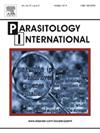美洲蝇致犬肠道假蝇病及绿绿杆菌引起的首例文献报道
IF 1.9
4区 医学
Q3 PARASITOLOGY
引用次数: 0
摘要
假酵母菌病发生在脊椎动物摄取经胃肠道存活的蝇卵或幼虫时,可能导致病理反应,但它们通常无法在宿主体内继续其生命周期。许多吹风蝇种类(双翅目:吹风蝇科)与人类和动物的兼性皮肤蝇病有关;然而,在动物中发现的吹蝇假蝇病病例很少。本文报道了2例由蝇类引起的犬假蝇病病例,其中1例经证实为Lucilia cuprina Wiedemann。狗的假孢子虫病病例很可能被低估了,因此考虑和识别这些事件作为胃肠道疾病的鉴别诊断以防止复发是很重要的。卫生当局应优先认识到苍蝇行为的特殊性,以制定控制战略并防止其对公共卫生的影响。本文章由计算机程序翻译,如有差异,请以英文原文为准。

Canine intestinal pseudomyiasis by blow flies and first documented case report caused by Lucilia cuprina in Central America
Pseudomyiases occur when vertebrates ingest eggs or larvae of flies that survive gastrointestinal passage and may result in pathological reactions, but they are usually unable to continue their life cycle in the host. Many blow fly species (Diptera: Calliphoridae) are associated with facultative cutaneous myiasis in humans and animals; however, very few cases of blow fly pseudomyiasis have been published in animals. In this report, two cases of canine pseudomyiasis caused by blow flies are documented, and Lucilia cuprina Wiedemann was confirmed as the species responsible in one of them. It is likely that cases of pseudomyiasis in dogs are being underestimated, so it is important to consider and identify these events as a differential diagnosis of gastrointestinal disease to prevent recurrences. Recognizing the particularities of blow fly behavior should be a priority for sanitary authorities to establish control strategies and prevent their impact on public health.
求助全文
通过发布文献求助,成功后即可免费获取论文全文。
去求助
来源期刊

Parasitology International
医学-寄生虫学
CiteScore
4.00
自引率
10.50%
发文量
140
审稿时长
61 days
期刊介绍:
Parasitology International provides a medium for rapid, carefully reviewed publications in the field of human and animal parasitology. Original papers, rapid communications, and original case reports from all geographical areas and covering all parasitological disciplines, including structure, immunology, cell biology, biochemistry, molecular biology, and systematics, may be submitted. Reviews on recent developments are invited regularly, but suggestions in this respect are welcome. Letters to the Editor commenting on any aspect of the Journal are also welcome.
 求助内容:
求助内容: 应助结果提醒方式:
应助结果提醒方式:


